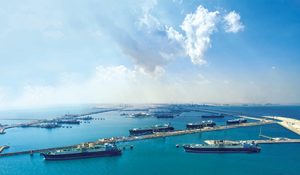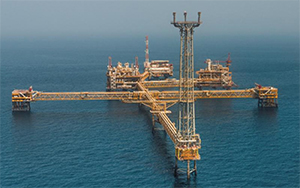Qatar is one of the world’s largest producers and exporters of natural gas – we explain the different types of gas the country produces.
Qatar is one of the world’s major producers of natural gas, a worldwide liquefied natural gas (LNG) giant, with the State sitting on huge reserves. Domestic companies such as Qatar Petroleum (QP) are all involved in the natural gas industry, alongside a number of foreign investors (see Company Activities in this section).
According to BP’s Statistical Review of World Energy 2020 report, Qatar has the third largest natural gas reserves, behind Russia and Iran, with 24.7 tn cubic meters (tcm). The report states that global proved gas reserves are sufficient to meet 50.9 years of global production at 2019 levels.
QP started the development drilling campaign for the offshore North Field East (NFE) project in April, previously known as the North Field Expansion Project. This phase of the NFE project will increase the Qatar’s LNG production capacity from 77 million tons per annum (Mtpa) to 110 Mtpa; the second phase, the North Field South Project (NFS), will increase production to 126 Mtpa.
Some residents and visitors to Qatar may find the unique vocabulary used in the oil, gas and petrochemical industry – or, as it is more commonly known, ‘OGP’ – hard to grasp. Here are some easy to digest facts about the main areas of the gas sector:

GTL: Gas‑to‑liquids
When natural gas is extracted from offshore reservoirs and brought up to the production station (platform), it is subjected to a process that separates the oil particles (condensates — light hydrocarbons including butane and propane) and water, which form a small percentage of the gas stream. The balance – pure, natural gas – is then fed via subsea pipelines to Ras Laffan Industral City (RLC).
This natural gas can then be processed into liquefied natural gas (LNG), as it is easy to transport, or routed to an alternative processing plant to be converted into other materials: diesel, lubricants, waxes and naphtha (a flammable oil containing various hydrocarbons). These are used to manufacture such things as talcum powder and liquid detergent.
Qatar’s ORYX GTL project in Ras Laffan employs the Fischer-Tropsch technology, which uses reactors and special catalysts in the conversion of synthesis gas into high‑quality products via a three–stage process:
- Reforming of natural gas: methane reactors with oxygen over a catalyst to form a synthesis gas (syngas), a mixture of carbon monoxide and hydrogen.
- Conversion of syngas using the Fischer-Tropsch technology: the most important step of the process, where a broad range of hydrocarbon streams are generated. Gas goes through special reactors and generates liquid hydrocarbons (condensate and syncrude).
- Product upgrade: using isocracking technology, the syncrude is converted into diesel, naphtha and liquefied petroleum gas (LPG).
LNG: Liquefied Natural Gas
Production companies search for evidence of oil and gas reservoirs, often found deep inside the earth, using sophisticated technology and drill wells in locations where it is likely to be found.
When the gas comes ashore from the gas fields (in Qatar this is the huge North Field), it is cleaned of impurities, such as hydrogen sulphide, carbon dioxide and water. Condensates are removed, then processed and sold separately.
The purified gas then enters a refrigeration unit that reduces its temperature and shrinks its volume by a factor of 600; in other words, 600 cubic feet of natural gas becomes one cubic foot of LNG, enough to generate about 100 kilowatts per hour of electricity. An average load of 4.7 mn cubic feet of LNG is usually carried by each tanker – enough to generate 482 mn kw/h of electricity or to power approximately 34,000 homes for a year.
Facilities used to convert natural gas to liquid are called trains – this is because of the sequential arrangement of the equipment required to process the gas.
Huge tanks store the LNG until it is loaded through a pipeline into tanks aboard LNG ships. Tanks and pipes are completely and efficiently insulated to keep the liquefied gas cold.
LNG must be maintained at below –82°C to remain a liquid. However, the insulated tanks and pipes are not enough to keep the temperature of LNG sufficiently low. Autorefrigeration is therefore used to help keep the liquefied gas at a constant temperature by maintaining it at its boiling point.
LNG is stored as a boiling cryogen, a substance used to produce very low temperatures, with a boiling point at around –84°C. Stored LNG is similar to boiling water, albeit much colder! The temperature of boiling water (100°C) does not change, even with increased heat, as it is cooled by evaporation (steam generation). In much the same way, LNG will stay at near constant temperature if kept at constant pressure. As long as the steam (LNG vapour boil-off) is allowed to leave the tank, the temperature remains constant.
When an LNG ship reaches the customer’s port, the liquefied gas is offloaded into insulated storage tanks and then processed through a regasification terminal that puts heat back into, and vaporises, the liquid. The gas is then transported as conventional pipeline gas.

LPG: Liquefied Petroleum Gas
LPG is refined from oil and natural gas the same way petrol is refined from crude oil. While LPGs may not be the primary activity of most energy companies, they are produced nonetheless because they are a byproduct of the refining process for other fuels.
When natural gas is drawn from the ground, about 90% of it is methane. The rest is in the form of various LPGs, which is separated from the methane before the methane is fed into pipelines for use in our homes. The amount of LPG that comes from natural gas varies, but it is usually from 1 to 3%, and mainly comprises propane or butane. It can be used to run vehicles such as lorries and buses, and for domestic cooking and heating. It is one of the most common alternative fuels used in the world today.
Propane and butane can be stored in liquid form with only moderate pressurisation; isobutane, which has the same simple chemical formula as butane but a different chemical structure, is also used. Usually, butane and isobutane are mixed with propane in various proportions, depending on the intended use of the fuel.
Propane is useful as a portable fuel (for example, when camping) because its boiling point is –42°C, meaning that even at very low temperatures, it will vaporise as soon as it is released from its pressurised container. This results in a clean‑burning fuel that doesn’t require much equipment to vaporise it and mix it with air.
Butane’s boiling point is approximately 0.5°C, so will not vaporise in very cold temperatures. It therefore has more limited uses and is mixed with propane instead of being used by itself.
CNG: Compressed Natural Gas
CNG is a fossil fuel substitute for petrol, diesel or LPG. It is more environmentally friendly as it causes less pollution, and gas‑fuelled vehicles are silent, perfect for densely populated urban areas. The Environmental Protection Agency in the US believes vehicles using CNG reduce carbon monoxide emissions by 90–97%, and CO2 emissions by 25%.
CNG is often confused with LNG and LPG: CNG is stored as a gas at high pressure; LNG is stored as an uncompressed liquid, while LPG is compressed.
CNG is lighter than air, so will not form a puddle like petrol or diesel. Any leaks will simply evaporate. Nor does CNG not have any noticeable smell; a distinctively noxious odorant (think of rotten eggs) is deliberately added as an alert to a leakage.
Author: Sarah Palmer
Copyright © Marhaba Information Guide. Reproduction of material from Marhaba Information Guide’s book or website without written permission is strictly prohibited. Using Marhaba Information Guide’s material without authorisation constitutes as plagiarism as well as copyright infringement.
